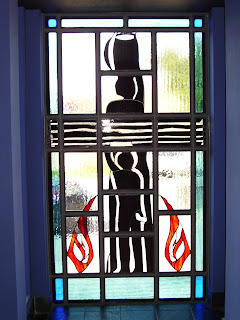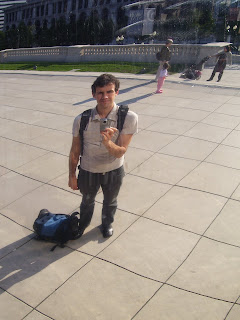
The two pictures I have chosen are good examples of what it means to do theology, to be Christian, in a place like Guguletu. In the above picture we see a stained glass window in the church building at JL Zwane. We can see that the shape of the cross is made up of people involved in activities of everyday life in the Eastern Cape, from where Xhosa speakers mainly originate. A woman holds her children, carries water on her head, and sticks she has gathered for firewood across her breast. What it means to embody the cross, the symbol of the Christian life in this place is to do the things that define ordinary life here. The Christian life and the everydayness of life's activities are indistinguishable. To be Christian is to be ourselves as we are and doing what we must do to survive. Family, food and drink, work and toil are all integral to the Christian life. On either side of the woman are flames representing not only the presence of God, whether in the burning bush or the tongues of fire at Pentecost, but also the cookfires over which meals are prepared and the stuff of daily nourishment is made. God sustains us, Chrisitans always say, not just in some metaphysical and intangible way, but by our "daily bread". It is a theology of embodiment, earthiness, and God's presence in the stuff of ordinary life. The whole of life is sacramental, not just the things going on in the sacred space of the sanctuary. The line between sacred and profane is blurred, even broken down, so that God is everywhere present, not limited and confined within one building or area of activity.
The second is a banner hanging on the pulpit in church, which reveals that concern for HIV/AIDS is central to the identity of the church. It isn't just hanging outside the sanctuary, or

inside on the wall, but on the pulpit itself, the central location from which the kerygma, the proclamation of the word of God, comes. By welcoming and creating a supportive place for people with HIV in the early 1990s, JL Zwane was looked down upon by many churches and people in the community. People with AIDS were regarded as sinners who had no place in the church, and JL Zwane was doing something profane by inviting them in. Groups who used the church as a meeting space began to refuse to come, or find other churches for fear that by setting foot on the premises of this church people would assume they were "positive." Many people criticized Rev. Xapile and JL Zwane, many people left the church. It has been a costly decision for JL Zwane to accept people with the disease when no other church in South Africa (according to Spiwo) was doing so. Although things have improved, and HIV sufferers are reached out to and accepted much more widely in community and in the country, it has been a very hard road. By identifying with those who are shunned and excluded, the church was itself shunned and excluded by many in the denomination and in the neighborhood. By putting this banner on the pulpit, that struggle, that costly proclamation of a message of love acted out in acceptance is made central to the identity of the church. It is a part of the sacred space. By including a message from someone who has HIV in every worship service, the struggle against the disease is sacramentalized. It is sacred, it is worship.
Something I will take back with me is that theology is not something that can be done purely in the abstract, in the language of supposed universals. It is always done in a particular space, which is wrapped up in the language and concepts in which theology is articulated. Christianity is not just a religion of abstract beliefs about the cosmos. It is lived and embodied in the dirt, and bodies, and struggles of everyday life. If the Christian message is not "God is here too" it is not, in my estimation, of much value.

2 comments:
Zach,
Extremely insightful. This is an amazing apology showing not only the importance of non-traditional theology, but also the real need for it as well.
Zack, I wholly concur with my boyfriend even though he cannot ever spell your name correctly, hehe, but I also really love your attention to the most obvious symbols in the sanctuary. Context is really meaningful when it comes to the gospel and this post is really powerful- thanks...ps, come home soon!
Post a Comment